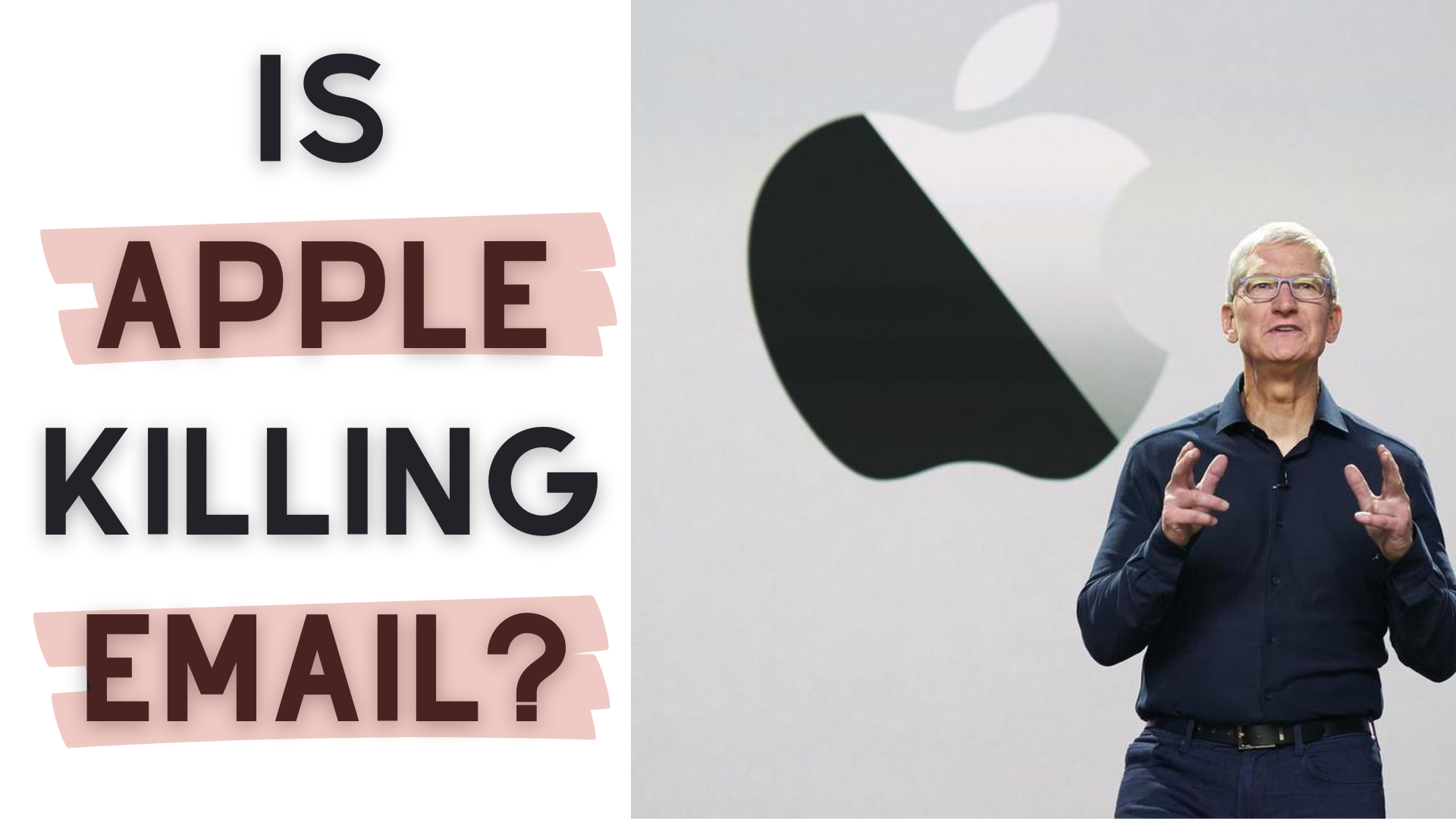Don’t know if you saw the news, but yesterday Apple dropped a bombshell on the email marketing community with their newest round of privacy updates.
Normally, when Apple makes these kinds of announcements, marketers brace for impact on what data social media platforms like Facebook and Instagram will have access to.
But this time, they told us they’re leaving Facebook alone.
And instead coming after a whole new channel…
…Email.
Yep, the medium that so many of us think of as an owned asset is now under a “data attack.”
With the coming update to Apple devices, we’re about to see information that marketers typically rely on to monitor list engagement, ensure email deliverability and properly segment their list disappear overnight.
It’s caused some to even suggest, “Apple is killing email newsletter metrics.”
Many in our industry believe Benedict is right.
And even that could be putting things lightly.
So what data exactly will Apple be restricting?
I want to be very clear with the language here so I grabbed this from Apple’s own press release:
“The new feature [of Mail Privacy Protection] helps users prevent senders from knowing when they open an email, and masks their IP address so it can’t be linked to other online activity or used to determine their location.”
Yep. That means exactly what you think it means.
Open rates will be a dead metric.
Subscriber location will be gone faster than you can say Wichita, Kansas.
And if that weren’t enough, Apple snuck another one in.
With a new feature called Hide My Email, users will be able to create disposable email addresses whenever they opt in to a form or place an order on a store. Here’s the prompt Apple will show users:
So to recap what’s coming, senders will no longer be able to see:
- Who’s opening their emails
- When people are opening their emails
- Where their subscribers are located
- And even what the true contact information of the subscribers is
Any one of these features could be disruptive for email and businesses that rely on email for profit.
But when you combine all four things with the fact that Apple has a 58% stranglehold market share of the email client market, this was a shockwave with ripples felt round the world.
Over the past 8 years, I’ve built a career writing and sending emails on behalf of brands of all sizes. From startups trying to make their first online sales to $100 million companies, I’ve seen first hand how important email is for brands to be able to get traction, hire new employees and get their products in the hands of people all around the world.
It’s much more than many people on the outside of our industry even know.
So I wanted to share my thoughts on these updates, how I’m preparing for the rollout and what you expect over the coming months as these changes get made to put yourself in the best position possible.
My Nostradamus Moment
Last year, when Apple announced the changes coming to iOS 14 and said they would be asking users to opt into tracking for apps like Facebook, I watched as advertisers around the globe panicked.
What seems like a simple change to Apple was actually a major disruption.
Because many businesses and people I know personally rely on data from Apple devices to properly manage tens of thousands dollars in ad spend every day on Facebook.
Without that data, it’s not just a few less orders for a brand.
It had the potential to make people lose clients, put people out of work and even cut off entire revenue streams from otherwise thriving companies.
So it was one of those “brace for impact” moments …. with months of build up to the update day.
And a potentially business ending change for a lot of people.
And despite people’s attempts to prepare for it, I don’t think any of us anticipated just how much data would be lost.
Some outlets have reported that as few as 4% of users have opted in to the tracking.
You don’t even have to be a data expert to know that not having access to 96% of the data you need for business is not good.
During that time, I remember not only were a lot of people scared but a lot of people started saying, “now’s the time to invest in email!”
“Move your fans over to an owned asset like email.”
And at the time, those people were right.
But I also remember having a fleeting thought, “What if they do this to email too?”
Now I didn’t declare this publicly.
So it’s easy to chalk it up to hindsight being 20/20 today.
But at the time, I was having some deliverability issues for one of our agency’s clients.
I remember doing a massive amount of research on all the best practices to get emails delivered, reading resources from both Apple and Gmail, getting a new IP address.
But no matter what we did we could not inbox properly.
It made me think, “Who really owns this email list?”
Here I was trying to contact all these subscribers who the client had worked hard to acquire and yet because of the inbox tools and software required to send the emails, we could not contact the vast majority of them.
And that’s when it occurred to me: Email isn’t really an owned channel. At least not in the ways we typically think.
It requires distribution and coordination just like Facebook, Instagram, and YouTube.
But even though I had that thought, I never expected the open rate to come under attack from Apple.
Especially because opening emails is a metric that even they recommend senders monitor and track to keep deliverability high.
The hypocrisy is beyond me.
But just like the changes to iOS 14 and Facebook, these changes are going to come whether or not any of us like it (or if Apple is conflicting their own advice with the move).
So what should you do?
Preparing For The End of Open Rates
First, do NOT panic. This is not great news but it’s definitely not the end of the world, especially not from a revenue perspective.
If we look at a similar channel (in terms of pushing notifications to a contact list) like SMS, we see it does JUST fine relying on clicks for signals of engagement instead of opens.
Second, remember that OPENING emails is only one signal of engagement to monitor for.
You can also practice good list hygiene by watching for things like purchase activity, on-site behavior, sign up date, and email clicks.
You’ll just need to create these segments and use that as your engagement benchmark as opposed to relying on things like opening an email to signal that a subscriber is still active (like many of us have done in the past).
(GOOD NEWS: Email service providers like Klaviyo make tracking these additional metrics easy within their segments)
Third, if deliverability has been an issue before, FIX it NOW!
Do it while you can still monitor your inboxing in the easiest way (monitoring open rates).
And also work to establish some key benchmarks for your click rates and revenue per email now so that you can see how you’re trending when you start flying blind in the fall.
Fourth, we’re going to have to (uncomfortably) forget things send time optimization and split-testing subject lines as optimization techniques.
They’re being taken out to pasture as we speak.
Personally I’ve never been a huge fan of send time optimization anyway, but if you are sending to large list and rely on split-testing for improved performance consider:
- Investing in your copywriting skills so that you can put your best foot forward with each send in the absence of testing. (Oh who do you know that can help you with that???🙋)
- Doing more optimizations within the body of the email to drive click rates higher. See some of those here and here. Your email creative, button copy and body text will be everything.
- Optimizing for other key metrics like click rate and revenue. But if you’re going to do revenue, you’ll likely need to increase the testing window (or perhaps Klaviyo can work on a faster data feed?)
Fifth, focus on relationships with your readers more than ever before.
This means if you’ve been guilty of treating email as if it’s just a coupon generating channel, it’s time to wake up.
Instead, use email as a place where you stay in touch with your fans, share cool stories and write content so good that your readers are excited to get your emails (and open whether you know it or not).
If all my open metrics disappeared tomorrow, I wouldn’t freak out because I’ve invested the time to make my emails something my subscribers look forward to reading.
Sixth, keep your head on a swivel for updates coming from each of the major ESPs. As of today (6/8/21), we’ve yet to hear a response from any of the major ESPs on best practices and compliance before the changes officially roll out.
Because in the days leading up to the changes with Facebook tracking, there were several updates that advertisers could make to dramatically lessen (domain verification, 2 factor authentication, etc.) that helped improve what data could pass.
Ultimately, the best thing that any of us can do right is keep prioritizing good content, keep investing in relationships with our customers and trusting that true fans will find us in the end.
And there’s still so much we don’t know yet…
What We Still Don’t Know
There are still a lot of questions left unanswered right now.
What metrics will deliverability depend on? Will there be new spam requirements or consequences for senders?
Will there be software or tools that come up with workarounds?
What will the impact of Hide My Email be on advertising and multi-channel businesses?
Will Apple roll out it’s own email tool?
What will others do in response?
Competitors like Google know how huge this is and have already started to take actions in response.
Within 24 hours of this news coming out, some Gmail users have reported seeing this update being pushed to their devices:
As email marketers, we deserve answers to these things. And I’m sure we’ll get them in the coming months and days.
But for now, remember that even though Apple chose violence against email, we’ll get through it.
Email is not going anywhere.
Just what it looks like … and the metrics we used to depend on to grow it will look very different.
Very soon.

